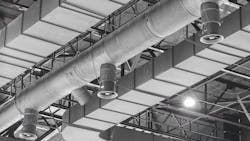5 Ways to Tackle HVAC Noise for a Quieter, More Comfortable Building
A noisy HVAC system can reduce productivity, put people in bad moods and interfere with customers’ perceptions of the building. Fortunately, there are numerous HVAC noise reduction strategies to consider.
Knowing the best options for the circumstances—and understanding the sound’s cause—can help facilities managers and other professionals address noisy systems and prevent them from causing long-term issues.
Install HVAC Equipment Away from Noise-Sensitive Areas
Succeeding with HVAC noise reduction strategies requires people to understand the impact of installing new equipment in certain areas over others. One of the first considerations is the likelihood of workers or customers hearing the sounds of a normally functioning unit while performing tasks, having meetings or handling other needs. This is especially important in open-office environments or settings where noises easily echo or seem particularly distracting.
Experts recommend creating buffer spaces by installing HVAC units close to less noise-sensitive areas. Possibilities include near bathrooms, storage closets and stairwells. Then, even if people occasionally hear the equipment running, they shouldn’t find it overly bothersome.
Another practical strategy is to get occupants’ feedback. People who spend hours daily and several days a week in the building should have valuable input that those who spend less time in the environment might not immediately consider.
When there’s no choice but to put HVAC units in highly populated areas, the best option is to use noise-dampening strategies around the equipment. Specialty enclosures paired with thick walls usually get the job done, though a good strategy is to get an external consultant to offer advice about the best design choices to make.
People should also consider building-related factors that could limit the noise-dampening methods used. Space that is rented or has historical significance must be addressed before proceeding.
Understand What Causes and Solves Common HVAC System Noises
One of the simplest strategies to separate normal HVAC noise from abnormalities is to become familiar with what the system sounds like when operating as it should. That makes deviations much easier to spot. Here are some of the most frequently seen issues and how to resolve them.
Broken cooler motor: An air conditioner’s cooler motor powers the fan blades. These electrical units can experience several issues. However, most are relatively easy to identify, causing affected units to emit screeching or squealing noises.
Air conditioners have two cooler motors because the units have internal and external fans. If the latter has issues, the noticeable sound may resemble a buzz instead of a higher-pitched sound. Regardless of which emits the bothersome noise, the best action is to unplug the equipment and schedule a technician callout.
Unattached fans: Air conditioners have outdoor condenser units and indoor blowers. These fans should stay attached during operation but can eventually become dislodged. If that happens, the associated noise can sound like banging, rattling or scraping, depending on how incorrect the fan’s position is within the unit. The noises should follow a uniform pattern as the air conditioner tries to regain its programmed state.
Objects trapped inside: If unusual noises come from an outdoor unit, check to see if the sound is due to trapped debris. This issue is more likely on heavily landscaped properties with many trees. The sound may begin shortly after harsh storms, usually due to twigs getting caught inside the unit. The outdoor fan components turn at least 1,800 rotations per minute. Keep yourself safe by always turning off the unit before investigating further.
Take Maintenance Seriously
Servicing systems at the appropriate intervals can reduce HVAC noise and much more. When technicians regularly assess units and take care of periodic needs, there’s a much better chance of them spotting problems before they cause strange sounds or other issues.
Plus, staying on top of maintenance brings other notable benefits. Replacing dirty filters can help save up to 15% on energy costs. Maintenance should usually occur during the spring and autumn so HVAC systems operate at peak performance during the two other seasons, which are typically more demanding.
Also consider how connected sensors can support a maintenance strategy. Many facilities managers have begun using these options to enhance their processes and find areas for improvement. The sensors vary in functionality, but many can detect abnormalities days before humans notice them. Sensor data can also be fed into building management systems, giving users more visibility and helping them see the benefits of optimizing HVAC systems.
Another smart and widely utilized option is to rely on a cloud-based platform to store equipment manuals, purchase documentation and more. Some offerings include features that allow technicians, property managers and others to set notifications about when certain maintenance tasks must occur. Creating a semi-automated system makes it easier to determine whether an oversight has created the need for HVAC noise reduction strategies.
Building an internal system for reporting noisy units can also ensure the associated problems are fixed promptly. Occupants who know how to alert maintenance teams to new things they notice are more likely to do it quickly. Such incoming data can aid technicians in triaging problems, especially while overseeing multiple sites or HVAC units.
Know the Connection Between Mounting Methods and HVAC Vibrations
Improper mounting methods can cause HVAC systems to vibrate, leading to constant and unpleasant noises. One potential mistake is rigidly attaching the unit to a slab, ceiling or wall. That approach may transmit vibrations through the associated structure, creating sounds that spread through it.
Ventilation ducts, air conditioning units and heat pumps are all examples of relevant equipment typically requiring vibration control. The fastest way to achieve it is to use vibroacoustic isolators to separate the vibration source from the structure. Doing this can absorb up to 99% of the vibrations coming from the equipment.
These isolators come in numerous types, such as spring hangers and sound absorbers. Most typically feature rubber or steel materials, and sometimes both. Choosing the best kind for HVAC noise reduction depends on understanding the vibration’s frequency. Rubber or elastomer products curb high-frequency vibrations, while spring mounts reduce lower-frequency ones.
HVAC Noise Reduction Is an Achievable Goal
Noisy HVAC systems can certainly be annoying. However, these strategies will help people evaluate the options and choose those best suited for addressing the matter.
About the Author

Emily Newton
Emily Newton is an industrial and tech journalist passionate about how technology is revolutionizing each sector. She has been writing and editing professionally for more than five years and is the editor-in-chief of Revolutionized.
